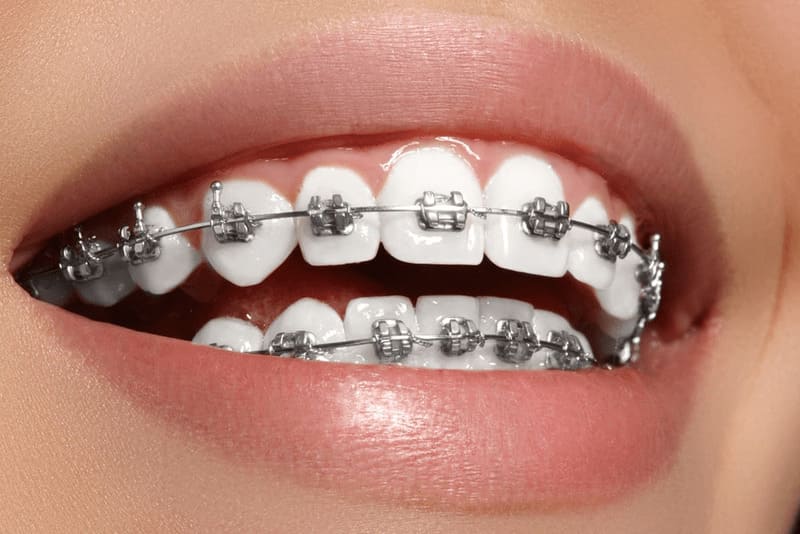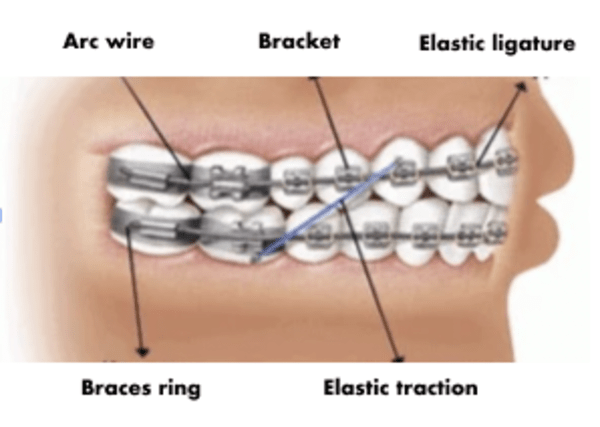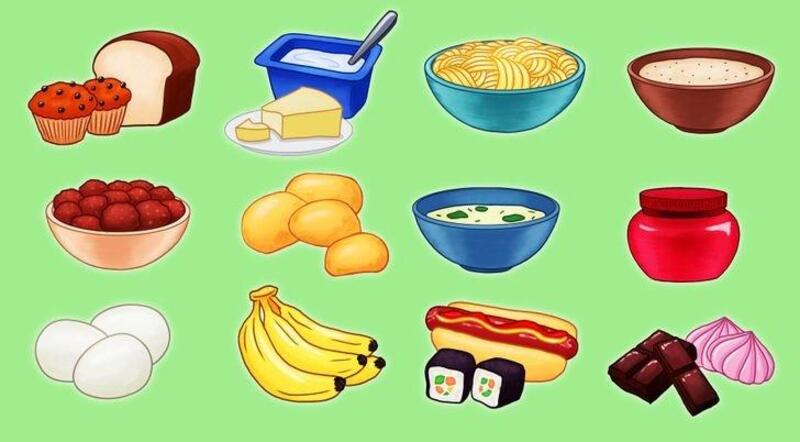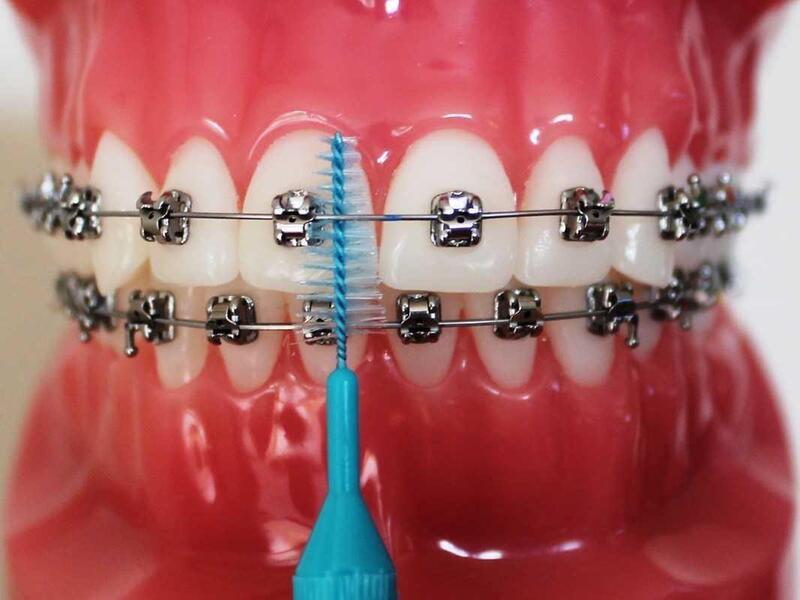The Dos and Don’ts of Eating with Braces

Braces are an effective way to correct bite at any age. In addition, they can help restore teeth alignment even in adulthood. However, several precautions must be taken during treatment, including recommending certain dietary restrictions.

Braces-Friendly Diet
Braces are pretty durable; their job is to move the teeth from the wrong position to the right one and secure the result. First, let’s look at how braces work.
The structure consists of an arch with shape memory and locks attached to the teeth, holding the arch in place. The orthodontist plans the treatment, choosing the arches. The arch tends to return to its original position by pulling the teeth, causing the roots of the teeth to pull on the ligaments and shift. As a result, the bone tissue decreases on one side and naturally builds up on the other. In this way, the tooth is moved or rotated to its correct position, firmly held by the ligaments.

Preparation for the bracket fitting process involves several stages: diagnosis, choice of treatment method, modeling and manufacturing of the orthodontic system, and preparation of the dentition (treatment of dental and gum disease). Braces fitting lasts 1-1.5 hours and is done during one visit to the doctor. The procedure is painless, but a patient may experience mild discomfort.
When wearing orthodontic appliances, there are several precautions:
- Perform thorough oral hygiene to remove plaque and prevent the development of tooth decay;
- Regular check-ups with your dentist;
- Stick to the recommended diet;
- Avoid sports that can cause injury;
- Avoid too hot or too cold drinks and food;
- Quit bad habits (smoking, biting your nails, and biting hard objects such as pens and pencils).
Following the recommendations on eating with braces is crucial to prevent patients from breaking the orthodontic appliances, damaging the teeth and gums exposed during treatment, and weakening the immune system. During treatment, a nutritious diet rich in vitamins and nutrients is recommended to help the body cope.
The menu of a patient wearing orthodontic appliances should contain proteins, fats, carbohydrates, minerals, and vitamins. Meals must be prepared and cut in a particular way. It is recommended to eat boiled, stewed food in small pieces. Biting into meat, fruit, or vegetables should be avoided; it is more convenient and safer to cut off small pieces with a knife and place them carefully in the mouth so that teeth and braces are not damaged by hitting or biting the fork.

In the first few days after fitting, you should be especially careful when having a meal and eat only soups, mashed potatoes, porridge, lightly warm drinks, and chopped fruit and berries without large or small pits.
The patient may eat a variety of soft, warm dishes made from:
- Meat (soups, burgers, stews, cooked sausages, rolls);
- Fish (boiled, braised fillets, burgers);
- Dairy (kefir, yogurt, sour cream, cottage cheese, cheesecakes, soft cheese);
- Cereals (porridge, casseroles);
- Flour (pancakes, muffins, bread, and rolls without crusts);
- Mushrooms;
- Pulses (soybeans, peas, beans, soft beans);
- vegetables and fruit (mashed potatoes, slices, sautéed vegetables, courgette caviar).
After each meal, cleaning the oral cavity of food debris and using a special rinse are important. Twice a day, special toothbrushes, flossing, pastes, and rinses are to be applied with particular care.
Don’ts of Eating with Braces
During the entire period of treatment, it is recommended to avoid the following:
- Biting bones, nuts, chips, crisps, biscuits, sunflower seeds, caramel, and bread crusts;
- Biting hard meat, apples, pears, and other hard fruit;
- Chewing gum, butterscotch candies, dried fruit, hard candy (nougat, marshmallow), and cheese;
- Hard meats, smoked meats;
- Colourful foods (blueberries or mulberries, coffee, tea, soluble drinks, wine, beetroot);
- Beverages such as Coca-Cola or Pepsi;
- Meals containing poppy seeds or sesame seeds;
- too hot or too cold drinks and meals.

These limitations are caused by the possibility of damage to the orthodontic appliances, teeth, and gums if the patient doesn’t follow the recommendations, complications such as breakage of the arch, loosening of the locks from the tooth surface, inflammation of the gums and the development of cavities can occur.
If braces break, they can injure the teeth, gums, and oral mucosa. If the braces fail, the patient should visit the dentist immediately. Attempting to repair the product yourself may lead to a worsening of the situation.
Patients should not give up eating a nutritious diet and switch to porridge and purees only. Successful bite correction requires restraint of the teeth and a balanced diet rich in vitamins and nutrients.
First Days in Braces
The few days or weeks after braces are the most difficult for the patient. After the procedure, there are often
- Increased salivation or, the other way round, dry mouth;
- Foreign body sensation, unpleasant taste, discomfort in the teeth;
- Diction disorders;
- Difficulty chewing food;
- Headache.
The mentioned discomfort may disappear within a few days or weeks. However, getting accustomed to the braces quicker is worth doing special exercises for the tongue and lips and practicing pronouncing phrases. Adjustment time to the braces is individual for each patient and depends on age, psychological characteristics, the type of braces fitted, and the complexity of bite anomalies.
Sometimes some conditions require immediate medical attention: the braces could irritate the gums, traumatize the mucous membrane of the mouth, and cause severe toothache, abscesses, or ulcers in the mouth. The specialist will check, correct and help to avoid serious complications.
In the first days and weeks after the alignment, you should:
- Practice good oral hygiene; brush your teeth at least twice daily, ideally after each meal. Use orthodontic toothbrushes, brushes, dental floss, rinses, and special pastes without abrasive particles for cleaning.
- Make a list of what you can eat with braces and follow a diet.
- If severe discomfort is experienced, choose semi-liquid or liquid foods with a straw or small spoon.
- Visit the dentist regularly.
- Pain medication can be taken in the first few days after the braces if there is moderate pulling pain.

To ensure that the adjustment period to the braces is quick and easy and the treatment is successful, it is essential to choose the dental clinic carefully. Seeing a highly qualified orthodontist ensures that your bite is corrected effectively and without complications.
Visit the Clinic of Aesthetic Dentistry. Our specialists will help you solve bite problems of different complexity.

